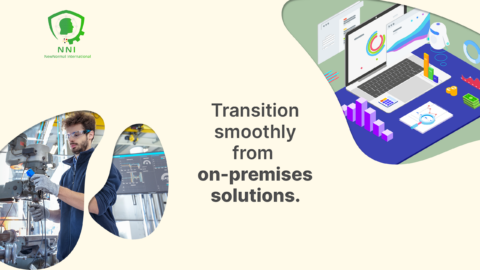Transition from On-Premises to Cloud Technologies
In today’s fast-evolving digital landscape, businesses are increasingly looking to transition smoothly from on-premises solutions to more flexible, scalable cloud-based systems. This strategic move is crucial for staying competitive and agile in a technology-driven market.
The Strategic Importance of Smooth Transition to Cloud Solutions
In today’s digital landscape, embracing the power of cloud computing is no longer a choice, but a necessity. The transition from on-premises solutions to the cloud represents not just a technological shift, but a transformative journey towards greater agility, scalability, and cost-efficiency. However, achieving a smooth and successful transition requires more than simply transferring data and applications. It demands a holistic approach that addresses both the technological aspects and the fundamental changes required in mindset and operational practices.
Imagine a business operating on a traditional, on-premises infrastructure, like a ship burdened by heavy anchors, tethered to physical limitations. The transition to the cloud is like setting sail on a vast, open ocean, filled with exciting possibilities and boundless opportunities. But just as a ship requires careful navigation to reach its destination, a successful cloud migration demands meticulous planning, execution, and a willingness to adapt to the new environment.
The technological aspects of the transition are crucial, involving the careful planning, selection, and implementation of cloud solutions that align with the business’s specific needs and goals. However, the true transformation lies in the accompanying shift in mindset and operational practices. This requires:
1. Embracing a culture of agility and innovation: The cloud environment fosters a dynamic and adaptable approach, encouraging experimentation, rapid iteration, and a willingness to embrace new technologies and methodologies.
2. Fostering collaboration and shared responsibility: The cloud breaks down traditional silos and promotes cross-functional teamwork, with shared ownership and accountability for cloud services and resources.
3. Prioritizing security and compliance: While the cloud offers robust security features, it also introduces new shared responsibility models. Businesses must be proactive in implementing security best practices and adhering to relevant compliance regulations.
4. Developing a continuous learning and improvement mindset: The cloud environment is constantly evolving, requiring businesses to adopt a culture of continuous learning and improvement, actively seeking new skills, knowledge, and expertise to remain competitive.
5. Empowering employees through training and support: A successful cloud migration relies on a skilled and empowered workforce. Investing in comprehensive training programs and providing ongoing support ensures that employees are comfortable and confident in the new environment.
By embracing these fundamental changes alongside the technological aspects, businesses can transform their cloud transition from a mere migration to a springboard for digital transformation. This journey unlocks a treasure trove of benefits, including:
Enhanced Scalability and Flexibility: The cloud allows businesses to scale their resources effortlessly, adapting to changing demands and seizing new opportunities on the fly.
Reduced Costs and Increased Efficiency: By eliminating the need for costly hardware and infrastructure, the cloud offers a more efficient and cost-effective way to manage IT resources.
Improved Business Continuity and Disaster Recovery: Cloud-based solutions enable businesses to recover quickly from disruptions and ensure business continuity in the face of unforeseen events.
Enhanced Collaboration and Global Reach: The cloud empowers teams to collaborate seamlessly from anywhere in the world, fostering innovation and driving global expansion.
Unleashing the Power of Innovation: The cloud provides access to a vast array of emerging technologies, allowing businesses to experiment and innovate at an unprecedented pace.
In conclusion, transitioning to the cloud is not merely about transferring data and applications; it’s about embarking on a transformative journey. By embracing the technological aspects alongside a shift in mindset and operational practices, businesses can unlock the full potential of the cloud, harnessing its power to achieve greater agility, scalability, cost efficiency, and ultimately, sustainable success in the ever-evolving digital landscape. So, hoist the sails, chart your course, and prepare to navigate the vast ocean of opportunities that await in the cloud.
Change Management in Transitioning to Cloud
Effective change management is key in ensuring a successful transition to cloud technologies. It requires careful planning, stakeholder engagement, and management of the technical and cultural changes within the organization.
Executive Coaching for Leading Digital Transformation
Leadership plays a pivotal role in driving the transition from on-premises to cloud solutions. Executive coaching services can provide business leaders with the skills and insights needed to lead this digital transformation effectively.
Effective Communication during the Transition
Effective communication is critical in managing the transition from on-premises to cloud solutions. Clear communication strategies ensure that all team members are aligned and aware of the changes, their roles, and the expected outcomes.
Leveraging Generative AI in Cloud Transition
The use of generative artificial intelligence can significantly aid in the transition process. AI can help in automating migration tasks, predicting potential challenges, and providing insights for more effective decision-making.
Conclusion Transition from On-Premises to Cloud
In conclusion, businesses aiming to “Transition smoothly from on-premises solutions” must adopt a comprehensive approach that encompasses technological, cultural, and operational changes. This strategic move is not just about adopting new technologies but also about transforming business processes for a digital future.
#DigitalTransformation, #CloudTransition, #BusinessTechnology, #ChangeManagement, #LeadershipInTech











